Aeroméxico
 | |||||||
| |||||||
| Founded | 1 October 1988; (Its predecessor was Aeronaves de México, founded on 14 September 1934, 81 years ago) | ||||||
|---|---|---|---|---|---|---|---|
| Commenced operations | 1 October 1988; 27 years ago (as Aerovias de Mexico SA de CV) | ||||||
| Hubs | |||||||
| Secondary hubs | |||||||
| Frequent-flyer program | Club Premier | ||||||
| Airport lounge | Salón Premier | ||||||
| Alliance | SkyTeam | ||||||
| Subsidiaries |
Aeroméxico Cargo Aeroméxico Connect Aeroméxico Express Aeroméxico Servicios | ||||||
| Fleet size | 68 | ||||||
| Destinations | 84 | ||||||
| Company slogan |
| ||||||
| Parent company | Grupo Aeroméxico | ||||||
| Headquarters | Mexico City, Mexico | ||||||
| Key people | Andrés Conesa Labastida (CEO) | ||||||
| Revenue |
| ||||||
| Net income |
| ||||||
| Employees | 13,745 (5 March 2014) | ||||||
| Website | www.aeromexico.com | ||||||
| Aeroméxico headquarters building | |
|---|---|
 | |
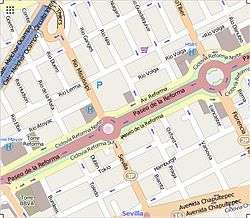 | |
| Former names | Edificio Centro Olímpico ("Olympic Center Building") |
| General information | |
| Status | Complete |
| Address | Paseo de la Reforma 445, Colonia Cuauhtémoc |
| Town or city | Mexico City |
| Country | Mexico |
| Coordinates | 19°25′31″N 99°10′21″W / 19.425377°N 99.1725283°W |
| Current tenants | Aeroméxico, Club Premier |
| Completed | 1968 |
| Owner | Aeroméxico |
| Height | 50 metres (160 ft)[4] |
| Technical details | |
| Floor count | 13 |
| Design and construction | |
| Architect | Fernando Pineda, Francisco J. Serrano, Luis MacGregor Krieger |
| References | |
| Emporis page[5][6] | |
Aerovías de México, S.A. de C.V.[7] operating as Aeroméxico, is the flag carrier[8] airline of Mexico based in Mexico City. It operates scheduled services to more than 56 destinations[9] in Mexico; North, South, and Central America; the Caribbean, Europe, and Asia. Its main base and hub is Mexico City International Airport, with a secondary hub at Monterrey.[1]
Grupo Aeroméxico includes Aeroméxico mainline and Aeroméxico Connect (regional subsidiary). The group held #1 place in domestic market share with 36.6%, and #2 place behind American Airlines with 15.3% of the international market share, in the 12 months ending March 2014,[10] becoming Mexico's largest domestic airline group. Aeroméxico is one of the four founding members of the SkyTeam airline alliance, along with Air France, Delta Air Lines, and Korean Air.
History
1934
The airline was established as Aeronaves de México on 15 September 1934,[11] by Antonio Díaz Lombardo. Its first aircraft was a Stinson SR. Julio Zinser piloted the maiden flight on the Mexico City - Acapulco route on 14 September 1934.
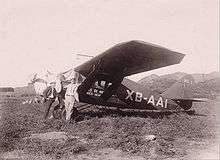
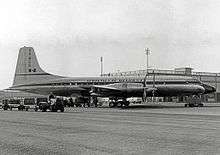
1940s
When World War II began, the airline continued to grow with the help of Pan Am, which owned 25% of the new Mexican airline. Aeroméxico saw few changes for the next two decades. However, during the 1950s, renovation began, and the airline took over various small competitor companies across the country, including Aerovías Guest (the second airline of the country at that time) that held the routes to Madrid and Paris. Aeroméxico added aircraft including the Douglas DC-3 and its successor, the Douglas DC-4.
1950s
During the late 1950s, the Douglas DC-4s were replaced by some pressurised Douglas DC-6s and two Bristol Britannias (the first turboprop passenger aircraft in the fleet) and in 1958, services were inaugurated to Idlewild Airport (now JFK) using the Britannias. The Mexico City-New York route would prove profitable for "Aeronaves" and its North American competitors. The airline was nationalised in 1959.
1960s
In the early 1960s, the fleet of Aeronaves de México (Aeroméxico) included Douglas DC-3, Douglas DC-6, and Bristol Britannia aircraft. Starting in 1961, "Aeronaves" began replacing its piston-engined aircraft with new jets. The first jet-engined aircraft were a pair of Douglas DC-8s. The DC-8s were used on routes within Mexico and to New York City. Between 1962 and 1963, Aeronaves de México (Aeroméxico) took over Aerovías Guest Mexico the second airline, and they were merged under the name Aeronaves de México. Later in the 1960s, more DC-8s were added and service to Europe was resumed, operated by two Comet-4C aircraft dry-leased by Aerovías Guest prior to the merger.
1970s

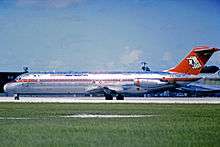
The 1970s brought dramatic changes for Aeroméxico. In 1970, under a government plan, Mexican domestic airlines were nationalized into an integrated air transport system under the control of Aeronaves de México. The system included eight smaller carriers, although these were later disbanded.[11] During the early 1970s, the remaining Douglas DC-6 and Bristol Britannia aircraft were retired. A new color scheme (orange and black) was introduced and the airline changed its name from "Aeronaves de México" to its current, shortened version of Aeroméxico in February 1972.
Aeroméxico, as one of the launch customers of the McDonnell Douglas DC-10-30 program, received the first of its aircraft in 1974. That same year the airline also took delivery of its first seven McDonnell Douglas DC-9-32s. During this period the airline's popularity and visibility grew dramatically. This was due in part to Aeroméxico's involvement in Mexican movies. Basically, every time characters in any movie produced in Mexico had to fly somewhere, they were depicted as flying on Aeroméxico aircraft. Service to Canada was initiated and in the early 1970s, two more DC-9-15s were added to the fleet.
1980s
The early 1980s were marked by expansion. A new color scheme was introduced (orange paint and silver), two DC-10-15s and a DC-10-30 were added in 1981 and in 1984. Aeroméxico, one of the launch customers of the McDonnell Douglas MD-82 (an elongated version of the DC-9), received its first two in late 1981. Between 1980 and 1981, eight more DC-9-32 aircraft were added. On 31 August 1986, the company suffered its only fatal accident outside Mexico when Aeroméxico Flight 498, a Douglas DC-9, approaching Los Angeles International Airport was struck by a light aircraft. Both aircraft then fell to earth in the Los Angeles suburb of Cerritos, California. All 64 passengers and crew on board the DC-9-32 were killed, as were the 3 people in the light aircraft and 15 people on the ground. After three years and a long trial, the aircraft's crew and the airline were found not to blame. This was because the pilot of the Piper had strayed into an air traffic control zone reserved for commercial flights. That same year, the airline acquired the charter carrier GATSA and used it for charter operations until December. In April 1988, the state-owned company was declared bankrupt and grounded for three months because of lack of organization, a fleet with an average of 20 years without a renovation plan and a depredating administration by the Mexican Government. In August, a privatization program was underway. This involved retiring the eight Douglas DC-8s along with the remaining ten DC-9-15 aircraft. Starting the privatization process included a new corporate name (Aerovias de Mexico SA de CV). The airline restarted operations with its predecessor's assets, including the headquarters building, maintenance hangar, some aircraft and some former Aeronaves de Mexico employees.

1990s
The early 1990s were turbulent times, with the rise in fuel costs due to the Gulf War, and a domestic fare war caused by start up airlines like TAESA, Servicios Aéreos Rutas Oriente, Aviacsa, among others, as well as constant labor problems. In April 1991 the first two 767-200ERs were introduced to the fleet starting to replace DC-10s in services to Europe, New York and Tijuana, another two 767-300ERs joined the fleet later that year. This was all a part of a renovation and expansion program to introduce 24 direct flights to Madrid and Paris from Mexico City with Boeing 767s as well as services to Frankfurt via Paris and Rome via Madrid.
In 1992 Grupo Aeroméxico was among other investors that failed to consummate the acquisition of Continental Airlines. After failing to invest in Continental, Aeroméxico acquired the bankrupt Aeroperú from the Peruvian government.
In 1993 Aeroméxico Group took over Mexicana, the second largest airline in the Mexican market under the same management. There was a great dispute in June 1993 with the pilot union regarding the transfer of flights to regional subsidiary Aeromonterrey, which had non-union pilots.[12] Between 1994 and 1995, the six DC-10 aircraft in the fleet were finally retired. Their last revenue flight was in 1995.
In December 1994 (three weeks after Carlos Salinas left the office), the first of several devaluations in the next 18 months started, giving way to an economic crisis in Mexico. As a consequence, Aeroméxico had to cut capacity and flights to Frankfurt and Rome were canceled, four McDonnell Douglas MD-80s and four Boeing 767s were returned to their lessors, early retirement for pilots and other staff was underway, and a new Boeing 767 due for delivery in April 1995 was instead transferred to another airline. Flights to Madrid and Paris were operated only by two Boeing 767-300ER jets.
In 1996 Cintra was created to prevent the two main carriers from going bankrupt. Some Boeing 757s of Aeroméxico's original renovation program were transferred to Mexicana and Aeroperú. The market and the airline recovered between 1996 and 1998; eight McDonnell Douglas MD80s were leased back along with two Boeing 767-200ERs.
The sale of Grupo Cintra was scheduled after several delays in September 1999, and with the looming presidential elections in 2000, everything was delayed once again. The ruling party lost the election after 70 years in office and all the policies changed. Due to the recession in 2000, the new government put everything on hold, waiting for better economic conditions to start the stock sell-off, and just when everything was about to start, the 11 September 2001 attacks occurred and nothing materialized since the two main carriers, Mexicana and Aeroméxico, were losing large amounts of money.
2000s

Between 2000 and 2005, Aeroméxico had an average fleet of 60 aircraft in mainline operation, plus 20 in Aerolitoral, as well as five CEOs during this time. After 9/11 and the Iraq War, it pursued a fleet renovation program. In 2003, the airline acquired its first Boeing 737-700 instead of the Boeing 717 as a replacement for its aging DC-9 aircraft. On 29 March 2006 Aeroméxico CEO, Andrés Conesa announced the inauguration of direct flights between Japan and Mexico City via Tijuana. This was after the purchase of two Boeing 777-200ERs, making Aeroméxico the third airline in Latin America to fly regularly to Asia, after Varig and the now defunct VASP. Since Varig's demise, Aeroméxico is currently the only airline with this service. Aeroméxico resumed its Mexico City-Tijuana-Shanghai route twice a week as of 30 March 2010. Suspension of this flight was due to the 2009 flu pandemic.
On 29 June 2006, the International Lease Finance Corporation (ILFC) and Aeroméxico announced that the airline would operate three Boeing 787 Dreamliners. Aeroméxico's deliveries were scheduled to begin in early 2012. From 2006, Consorcio Aeroméxico S.A. de C.V., the parent company of Aeroméxico at the time, faced large debts and had no profits to pay them off, so it offered Aeroméxico for sale in 2007. In early October, a week-long auction was held, with Grupo Financiero Banamex competing against the Saba family. On October 17, 2007, Banamex offered the highest bid and purchased the airline for US$249.1 million. In October 2010, Aeroméxico's largest competitor, Mexicana de Aviacion, filed for bankruptcy and was placed in administration.
2010s
Delta/Aeroméxico alliance
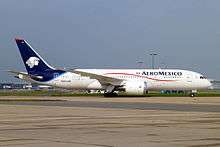
In 2011, Delta Air Lines and Aeroméxico signed an enhanced commercial alliance, building on an original agreement from 1994.[13] The 2011 agreement provided for codeshare on all the carriers' Mexico–US flights; Delta investing 65 million USD in Aeroméxico shares; and Delta gaining a seat on the Aeroméxico board of directors. In March 2014, the airlines opened Tech Ops Mexico, a 55 million USD joint maintenance, repair and overhaul facility in Queretaro City, Mexico.[14] In March 2015, the airlines filed applications for antitrust immunity, a first step in the creation of a 1.5 billion USD joint cooperation agreement (JCA) that will allow Delta and Aeroméxico to jointly sell, and share costs and profits on all Mexico–U.S. routes.[13] In May 2015, Mexican regulator approved the JCA; and in the same month the Mexican Senate approved Open Skies between the U.S. and Mexico. The approval of the JCA by the United States Department of Transportation is still pending.[15]
Dreamliners
On 25 July 2012, Aeroméxico CEO Andrés Conesa announced the purchase of six Boeing 787-9 Dreamliners. The new order was added to the package of 20 aircraft that the company had announced in 2011 and nine more Boeing 787-8 Dreamliner already provided. The delivery of the Dreamliners began in the summer of 2013. The total investment is US$11 billion and includes the acquisition of 90 Boeing 737-8 MAX which will be delivered from 2018.[16][17] The airline took delivery of its first Boeing 787-8 Dreamliner (albeit leased from ILFC) in early August 2013 and officially launched commercial service on 1 October 2013.[18]
New technology
In 2016, Aeroméxico added 2Ku wireless Internet service by Gogoto some 737-800 aircraft,[19] including access to Netflix. On its 787-8 and 787-9 Dreamliners it added Panasonic broadband Internet, and on Embraer narrowbody aircraft, streaming entertainment via Gogo's Gogo Vision.[20] In July 2016, the airline launched a completely new website, new check-in kiosks at Mexico City airport, and announced plans to launch a completely new mobile app in the Autumn of that year.[21] That same year, the airline also co-sponsored the launch of startup accelerator MassChallenge in Mexico.[22]
Corporate affairs
The company is run from its landmark headquarters at Paseo de la Reforma 445, Colonia Cuauhtémoc, Cuauhtémoc borough, Mexico City.[23] There is small U.S.administrative office in Houston.[24]
Destinations
New destinations
In an attempt to gain more worldwide presence and strengthen its network and to make connections easier and more frequent, Aeroméxico has started to develop new international markets. From 2006 it started operations to Tokyo from Mexico City via Tijuana. Service to Shanghai from Mexico City via Tijuana began in May 2008. New destinations in 2014-2016 included Panama City (Panama), Santo Domingo, Vancouver, Toronto, Boston, Medellín, Amsterdam, Cozumel, and Austin (Texas).[25] The airline also plans to launch service to Beijing from Tijuana sometime in 2017.[26]
Codeshare agreements
Aeroméxico codeshares with the following airlines:[27]
Bus services from Tijuana
Aeroméxico contracts with Intercalifornias to offer bus service from Tijuana to cities in California. In order to board the bus, a passenger must have a ticket to or from Tijuana Airport on Aeroméxico.[28]
Fleet
As of November 2016 the Aeroméxico all-Boeing mainline fleet consists of the following aircraft:[29][30][31]
| Aircraft | In Fleet | Orders | Passengers[32] | Notes | ||||
|---|---|---|---|---|---|---|---|---|
| C | W | Y | Total | |||||
| Boeing 737-700 | 19 | 0 | 12 | 18 | 94 | 124 | Being replaced by 737-800 | |
| Boeing 737-800 | 34 | 22 | 16 | 18 | 126 | 160 | ||
| Boeing 737 MAX 8 | 0 | 60 | First delivery in October 2017 | |||||
| Boeing 777-200ER | 4 | 0 | 49 | 0 | 228 | 277 | Will be replaced by Boeing 787-9 | |
| Boeing 787-8 | 9 | 0 | 32 | 0 | 211 | 243 | ||
| Boeing 787-9 | 2 | 4 | 36 | 0 | 238 | 274 | First aircraft delivered in Quetzalcóatl livery[30] | |
| Total | 68 | 86 | ||||||
Retired fleet
Subsidiaries
- Aeroméxico Connect, formerly Aerolitoral, a regional airline based at General Mariano Escobedo International Airport in Monterrey.
- Aeromexico Contigo, Aeromexico's brand for select US-Mexico flights.[33][34]
- Aeromexico Express , a commuter airline based at General Mariano Escobedo International Airport in Monterrey. It is a partnership between Aeromexico and Aeromar.[35]
Former Subsidiaries
- Aerovias Guest.
- Aeroperú, Peru's national flag carrier based in Lima International Airport.
- Mexicana, from 1993 to 1995.
- Aeromexpress, a cargo handler based at Mexico City International Airport in Mexico City.
- Aeroméxico Travel, a charter airline based in Cancún International Airport.
Slogans
- 1960s-1970s - Mexico's largest airline
- 1990s - La linea aerea mas puntual del mundo [36]
- Before 2009 - Travel the world (Vamos por el mundo) [37]
- 2010–2012 - A donde te lleven tus sueños
- 2012–2013 - Nunca nos detenemos
- 2013–2015 - La linea que nos une
- 2016–present - La linea de los mexicanos y del mundo
- English slogan: "Mexico's Global Airline"[2]
Incidents, accidents and Hijackings
Aeronaves de México
- 26 March 1954 near Monterrey, México - XA-GUN a Douglas DC-3.[38][39]
- 2 June 1958 near Guadalajara, México - XA-MEV a Lockheed 749A Constellation[40][41]
- 19 January 1961 in New York, New York (Idlewild) - XA-XAX a Douglas DC-8-21[42]
- 13 August 1966 near Acapulco, Mexico - XA-PEI a Douglas DC-8-51.[43]
- 24 December 1966 Lake Texcoco, Mexico - XA-NUS a Douglas DC-8-51[44]
- 12 June 1967 near La Paz, México - XA-FUW a Douglas DC-3A[45]
AeroMexico
- On 20 June 1973 Douglas DC-9-15 XA-SOC near Puerto Vallarta, Mexico, Aeroméxico Flight 229, a daily service from George Bush Intercontinental Airport to Lic. Gustavo Díaz Ordaz International Airport, crashed into the side of a mountain while on approach, killing all 27 people on board.[46]
- 2 September 1976 Douglas DC-9-15 XA-SOF at Leon/Guanajuato-Del Bajio Airport[47]
- On 27 July 1981, Aeromexico Flight 230 XA-DEN a Douglas DC-9-32 crashed while landing in Chihuahua, killing 32 of the 66 people on board.[48]
- 8 November 1981 XA-DEO a Douglas DC-9-32 in Sierra de Guerrero, México.[49]
- On 31 August 1986 Aeromexico Flight 498, operated with a McDonnell Douglas DC-9-32, was on its final approach into Los Angeles International Airport when it collided with a Piper PA-28 Archer over Cerritos, California. The resulting crash killed all 67 people on both aircraft and 15 people on the ground in Cerritos.
- On 6 October 2000, Aeroméxico Flight 250 N936ML a Douglas DC-9-31 at General Lucio Blanco International Airport, Reynosa, Mexico.[50]
- On 9 September 2009 Aeroméxico Flight 576 was hijacked between Cancún and Mexico City.
See also
References
- 1 2 3 "About Us", Aeromexico website, retrieved 2015-09-03
- 1 2 aeromexico.com
- 1 2 "Grupo Aeromexico S.A.B. De C.V. Releases Results for the Fourth Quarter and Full Year 2011". Reuters. 21 February 2012. Retrieved 23 February 2012.
- ↑ "Aeroméxico Reforma" on Emporis site
- ↑ "Edificio Centro Olímpico", Una Vida Moderna
- ↑ "Aeroméxico, edemx.com". Retrieved 24 April 2015.
- ↑ "Report on Actions of Social Responsibility." Aeroméxico. 41 (43/44). Retrieved on 4 December 2010. "Paseo de la Reforma 445, Col. Cuauhtémoc. C.P. 06500 México D.F."
- ↑ "Aeroméxico, la línea bandera del país", El Universal, 10 December 2010
- ↑ Aeroméxico. "Aeroméxico - Destinos Aeroméxico". Aeroméxico. Retrieved 24 April 2015.
- ↑ "Aeromexico outlines its revenue and network strategy in an uncertain Mexican market". Retrieved 24 April 2015.
- 1 2 "Directory: World Airlines". Flight International. 27 March 2007. p. 49.
- ↑ ITF News. Retrieved 24 April 2015.
- 1 2 "Delta and Aeroméxico: A 21-year partnership", Delta Air Lines News Hub, November 18, 2015
- ↑ "Delta and Aeromexico Create Enhanced Commercial Alliance", PR Newswire, August 10, 2011
- ↑ "Delta evaluates COFECE’s Joint Cooperation Agreement resolution", Delta Air Lines News Hub, May 2, 2016
- ↑ "Boeing, Aeromexico Announce Commitment for 100 Airplanes - Jul 25, 2012". Boeing.mediaroom.com. 25 July 2012. Retrieved 2012-10-06.
- ↑ "Finanzas - Aeroméxico invertirá 11 mil mdd para comprar 100 aviones". El Universal. 25 July 2012. Retrieved 2012-10-06.
- ↑ Linda Blachly (14 June 2013). "Aeromexico to take delivery of first 787 in August". ATWOnline. Retrieved 2013-06-30.
- ↑ "Gogo's 2Ku Technology Takes Flight on Aeromexico", PR Newswire, April 21, 2016
- ↑ "Inflight Entertainment and WiFi", Aeroméxico website
- ↑ Álvarez, Domingo (August 2016). "Las puertas del cielo (The gates to heaven)". Aire. Grupo Expansión: 82. Retrieved 6 August 2016.
- ↑ "Aeroméxico apoya la iniciativa de MassChallenge" (Aeroméxico supports the MassChallenge initiative), Aeroméxico website
- ↑ "Report on Actions of Social Responsibility." Aeroméxico. 4/44. Retrieved on 4 December 2010. "Paseo de la Reforma 445, Col. Cuauhtémoc. C.P. 06500 México D.F."
- ↑ "Contact Us." Aeroméxico United States. Retrieved on 18 September 2014. "Aeromexico Consumer Relations 3663 N. Sam Houston Parkway E. Ste. #500 Houston, Texas 77032"
- ↑ Aeromexico Press Room
- ↑ http://www.sandiegouniontribune.com/news/2016/sep/06/tijuana-beijing-flight-planned-2017/
- ↑ "Profile on Aeromexico". CAPA. Centre for Aviation. Archived from the original on 2016-10-30. Retrieved 2016-10-30.
- ↑ "Tijuana - California Cities." Aeroméxico. Retrieved on 19 April 2014.
- ↑ "Aeroméxico Fleet Details and History". Planespotters.net. 22 November 2016. Retrieved 23 November 2016.
- 1 2 "Quetzalcóatl, el nuevo embajador de Aeroméxico en el mundo" [Quetzalcóatl, Aeroméxico's new ambassador to the world] (in Spanish). El Universal. 12 October 2016. Retrieved 13 October 2016.
- ↑ http://www.seatguru.com/airlines/AeroMexico/information.php
- ↑ "Aeromexico: Our Fleet". Aeromexico.com. Retrieved 2014-04-16.
- ↑ http://www.prnewswire.com/news-releases/aeromexico-announces-launch-of-new-aeromexico-contigo-product-211882931.html
- ↑ http://aeromexico.com/us/promotions/fare-sales-and-special-offers/am-contigo.html
- ↑ http://www.ch-aviation.com/portal/news/26699-aeromar-airlines-to-operate-its-atr72-600s-for-aeromxico-express
- ↑ http://aeromexico.com/en/about-us/history-advertising/?site=us
- ↑ http://www.slogans.de/slogans.php?BSelect%5B%5D=29320
- ↑ "ASN Aircraft accident Douglas C-53-DO (DC-3) XA-GUN Monterrey". Aviation-safety.net. 25 March 1954. Retrieved 2012-10-06.
- ↑ "Accident Database: Accident Synopsis 03251954". Airdisaster.com. 25 March 1954. Retrieved 2012-10-06.
- ↑ "ASN Aircraft accident Lockheed L-749A Constellation XA-MEV Guadalajara Airport (GDL)". Aviation-safety.net. 2 June 1958. Retrieved 2012-10-06.
- ↑ "Accident Database: Accident Synopsis 06021958". Airdisaster.com. 2 June 1958. Retrieved 2012-10-06.
- ↑ "ASN Aircraft accident Douglas DC-8-21 XA-XAX New York-Idlewild International Airport, NY (IDL)". Aviation-safety.net. 19 January 1961. Retrieved 2012-10-06.
- ↑ "ASN Aircraft accident Douglas DC-8-51 XA-PEI Acapulco". Aviation-safety.net. 13 August 1966. Retrieved 2012-10-06.
- ↑ "ASN Aircraft accident Douglas DC-8-51 XA-NUS Lake Texcoco". Aviation-safety.net. 24 December 1966. Retrieved 2012-10-06.
- ↑ "ASN Aircraft accident Douglas DC-3A-197D XA-FUW La Paz". Aviation-safety.net. 12 June 1967. Retrieved 2012-10-06.
- ↑ "ASN Aircraft accident McDonnell Douglas DC-9-15 XA-SOC Puerto Vallarta Airport (PVR)". Aviation-safety.net. 20 June 1973. Retrieved 2012-10-06.
- ↑ "ASN Aircraft accident McDonnell Douglas DC-9-15 XA-SOF Léon Airport (BJX)". Aviation-safety.net. 2 September 1976. Retrieved 2012-10-06.
- ↑ "ASN Aircraft accident McDonnell Douglas DC-9-32 XA-DEN Chihuahua Airport (CUU)". Aviation-safety.net. 27 July 1981. Retrieved 2012-10-06.
- ↑ "ASN Aircraft accident McDonnell Douglas DC-9-32 XA-DEO Zihuatanejo". Aviation-safety.net. 8 November 1981. Retrieved 2012-10-06.
- ↑ "ASN Aircraft accident McDonnell Douglas DC-9-31 N936ML Reynosa-Gen Lucio Blanco Airport (REX)". Aviation-safety.net. 6 October 2000. Retrieved 2012-10-06.
External links
| Wikimedia Commons has media related to Aeroméxico. |
- Official website (English)
- Official website (Spanish)
- Aeroméxico (old site) (Archive)
- Aeroméxico (old site) (Spanish) (Archive)
- Consorcio Aeroméxico at the Wayback Machine (archive index) (Spanish)
- Amateur Aeroméxico Fleet Detail

_(2).jpg)
.jpg)
.jpg)